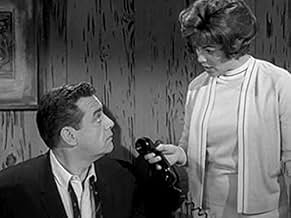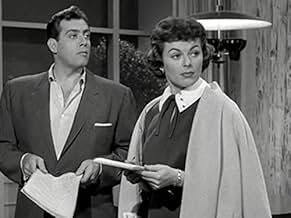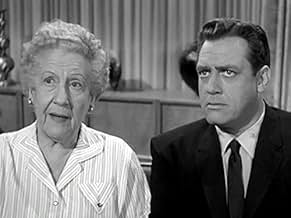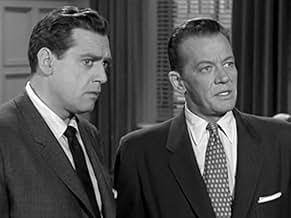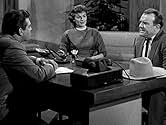The trials of a master criminal defense attorney handling the most difficult cases in support of the innocent.The trials of a master criminal defense attorney handling the most difficult cases in support of the innocent.The trials of a master criminal defense attorney handling the most difficult cases in support of the innocent.
- Won 3 Primetime Emmys
- 7 wins & 7 nominations total
Browse episodes
Featured reviews
The "Perry Mason" character, as developed by Erle Stanley Gardner in the early 1930s, was a "fighter", in the author's words; like Gardner himself, a successful and ingenious lawyer, the fictional lawyer-detective enjoyed seeking out the truth in the field--whether he was finding a body, bending a law in order to fight for his client or testing an hypothesis--as much as he enjoyed arguing a case within the arena of a courtroom. Immensely popular from the beginning, the character was never changed by Gardner. And although the series on television was subtly altered in many ways, and enjoyed format alterations, I assert that nothing essential was ever altered about Mason nor his main "foils". At the beginning, the cast consisted of Raymond Burr as Mason, William Hopper as his detective pal Paul Drake, pretty Barbara Hale as his right-hand girl and secretary Della Street, William Talman as Hamilton Burger his chief courtroom enemy, and Ray Collins as Lt. Arthur Tragg of Homicide. Cases began in many different ways; chiefly with a future accused murderer being victimized by someone else, or with a client coming to ask Mason's help. Had the show's writers found a way to state a categorical purpose for Mason to explain why he was taking each case, the fine power of these dramatic stories could have been increased. But the chief quality of the interesting narratives I suggest was rather, usually, watching Mason trying many ways to find out the truth about what had been done in some situation in order to prove the innocence of his client of a murder; that, plus the many characters who people over 250 separate episodes. Many fine writers and directors created stories for "Perry Mason"; some episodes were adaptations of Mason novels. And with Gardner working closely with executive producer Gail Patrick Jackson, the original entries were held strictly and successfully to the author's conception of the character. Talents as famous as Jack Arnold, Earl Bellamy, László Benedek, script consultant Arthur Marks, Arthur Hiller, Ted Post, Vincent Mceveety, Robert Sparr, Gerd Oswald, Andrew Mclaglen and Christian Nyby were in charge of the "Mason" cameras; writers for the series included True Boardman, Robert C. Dennis, John Elliotte, Jackson Gillis, Laurence Louis Goldman, Seeleg Lester, Orville H, Hampton, Laurence Marks, Bob and Esther Mitchell Jonathan Latimer, Samuel Newman, Helen Nielsen, Mann Rubin, Sy Salkowitz, Stirling Silliphant, Barry Trivers, Al C. Ward, Maurice Zimm and Gene Wang, among others. Mason employed a young lawyer, played by Karl Held, for one season; Richard Anderson, Wesley Lau, Dan Tobin and Lee Miller were regulars for varying lengths of time. But the glory of the series, i assert, was its guest stars. Apart from younger actors chosen for their looks, almost every other part was well-cast and the enactors successful in creating a character. The producers also used only about ten judges, notably S. John Launder, Willis Bouchey, John Gallaudet, Kenneth Macdonald and one female jurist. But the courtrooms in which Mason appeared ranged all over the state of California, from a military tribunal to small town courts to the great Los Angeles arena. Almost as numerous were the sites where Mason and Drake discovered clues, bodies and trouble; because Mason was a fighting man at heart, his favorite ploy was to plant false evidence to force overworked police to investigate some aspect of the case, to meet with someone in order to goad them into revealing something and to dispatch Drake or other operatives to expand his power of search and investigation. For me as a writer and viewer, the fun lay not so much in solving the crime along with Mason--although guessing the murderer's identity was enjoyable--but in watching the fine actors hired to don hats (as devices of characterization) and to take part in an interesting ethical exercise. Mason's ingenuity and lack of pretension endeared him to me, and to millions of viewers. Fine composers such as Jerry Goldsmith and Fred Steiner, who created the show's them, worked for the producers; and the cinematography and lighting was always above average for B/W television. But guest stars such as Keith Andes, Walter Pigeon, Whitney Blake, Pippa Scott, Cecil Kellaway, Gail Kobe, Paul Cavanagh, Benson Fong, Stacy Graham, Douglas Kennedy and Vaughn Taylor at last were who kept me, and other viewers, coming back every week. This is a most watchable narrative program; one-of-a-kind and still very enjoyable.
Everything about this series was perfect, from the acting, to the scripts, to the directing, and even to the fact that black and white was used even after the advent of color. Of course, Raymond Burr WAS Perry Mason, just about the world's greatest defense attorney, who stops at NOTHING in his search for the truth. The supporting cast was also excellent, and the guest stars, unlike in so many other series, were always of a high calibre. Some might say that the scripts were a bit formulaic, but within the basic format, over the 10 year run of the series there was infinite variety in the details of each show, with enough unexpected plot twists to constantly keep any audience guessing. The atmosphere was perfect: black and white lent a mysterious, almost gothic feeling to the episodes, which at the same time was beautifully contrasted with Perry Mason's ice cold reasoning and razor sharp sense of right and wrong. There are so many other things I could say about this series; perhaps it is best left at saying that this is the one, the only court drama, probably the best TV drama in general, and definitely one of the ten greatest series of all time.
For nine seasons and over 250 episodes Perry Mason ruled the television roost, it was the ratings flagship for CBS. Saturday nights at 7:30 this show was a viewing requirement in my household.
The show had a built in audience from the start with the millions of mystery fans who loved Erle Stanley Gardner's criminal defense attorney who always defended the innocent and never lost a case. Those parameters for the television series had to be respected. But also the right actor had to be found to play Mason.
One of the highest pieces of praise I ever read was Erle Stanley Gardner himself saying that Raymond Burr completely fitted his concept of the character he created. When you've got that kind of endorsement as well as the ratings to back it up, I'm sure the show could have run forever.
A really solid group of character players made up the cast here. Take a look at the credits on the pages here for Burr, Barbara Hale as Della Street, William Talman as District Attorney Hamilton Burger, William Hopper as Perry's private detective Paul Drake and Ray Collins as Police Lieutenant Tragg seem like they appeared in some of the best movies ever before going to series television.
Collins began experiencing health problems and first Wesley Lau and later Richard Anderson took the load from him. When Collins died in 1965 Anderson was the official cop for the series last year.
So indelible an impression this cast made on viewers minds that when CBS sought to revive Perry Mason in the middle seventies with a younger cast, the public viewed other stations in droves. Even with Collins, Hopper, and Talman all gone at that point, no one would accept their replacements.
The writers given the constraints of an hour television show managed to respect Erle Stanley Gardner's parameters and did a beautiful job with each and every episode.
This is what a good television series is all about.
The show had a built in audience from the start with the millions of mystery fans who loved Erle Stanley Gardner's criminal defense attorney who always defended the innocent and never lost a case. Those parameters for the television series had to be respected. But also the right actor had to be found to play Mason.
One of the highest pieces of praise I ever read was Erle Stanley Gardner himself saying that Raymond Burr completely fitted his concept of the character he created. When you've got that kind of endorsement as well as the ratings to back it up, I'm sure the show could have run forever.
A really solid group of character players made up the cast here. Take a look at the credits on the pages here for Burr, Barbara Hale as Della Street, William Talman as District Attorney Hamilton Burger, William Hopper as Perry's private detective Paul Drake and Ray Collins as Police Lieutenant Tragg seem like they appeared in some of the best movies ever before going to series television.
Collins began experiencing health problems and first Wesley Lau and later Richard Anderson took the load from him. When Collins died in 1965 Anderson was the official cop for the series last year.
So indelible an impression this cast made on viewers minds that when CBS sought to revive Perry Mason in the middle seventies with a younger cast, the public viewed other stations in droves. Even with Collins, Hopper, and Talman all gone at that point, no one would accept their replacements.
The writers given the constraints of an hour television show managed to respect Erle Stanley Gardner's parameters and did a beautiful job with each and every episode.
This is what a good television series is all about.
More than 40 years since the series debut, Perry Mason is still a classic, and is highly watchable today without seeming dated. The first half of the show tells the story of the events leading up to the murder and the preliminary investigation of the crime, while the second half of the hour dealt with the subsequent trial, where Mason exposed the truth in the courtroom. The plots were quite complex at times, but the writers also treated viewers with intelligence. The acting was superb by all, and even the bit players do an excellent job. Probably my favorite character was private detective Paul Drake, whom apparently could dig up any fact no matter how obscure within a short period of time. Much better than the 2 hour movies produced in the 1980s and early 90s, Perry Mason will always be a classic in the history of television.
The original "Perry Mason," in glorious black & white, is in the tradition of the great film noir films of the '40s and '50s. The cases have a poetic reality to them, clashing and understandable motives, psychology, and murder. Because the motives of all involved are understandable, there is not lacking a painful sympathy for those caught up in the circumstances described, even for the perpetrator. But there is a grim darkness to the program as well. The program gradually ran down during its life, so that, when it went off the air, it was probably time. The original 1957-1958 season was the best, with the most intricate plots and with Perry Mason a wiseguy thorn in the side of the police. The cast is perfect, and even the score fits perfectly this brooding and ironic look at life and fate.
Storyline
Did you know
- TriviaWhen Raymond Burr missed several episodes due to illness, he was replaced by several guest attorneys who were played by Bette Davis, Walter Pidgeon, Hugh O'Brian, Michael Rennie, and Mike Connors.
- GoofsPerry Mason's office is given as on the 9th floor of the fictional "Brent Building" in Los Angeles, and has a distinctive terrace outside (as does the next-door office in S.8 Ep. 30). However, establishing shots of the exterior use a photo of a plain-sided office building with no balconies or terraces on the 9th floor, or anywhere else.
- Quotes
Hamilton Burger: Incompetent, irrelevant, and immaterial!
- ConnectionsFeatured in The Honey Pot (1967)
Details
- Release date
- Country of origin
- Language
- Also known as
- Перрі Мейсон
- Filming locations
- Production companies
- See more company credits at IMDbPro
- Runtime1 hour
- Color
- Sound mix
- Aspect ratio
- 1.33 : 1
Contribute to this page
Suggest an edit or add missing content






